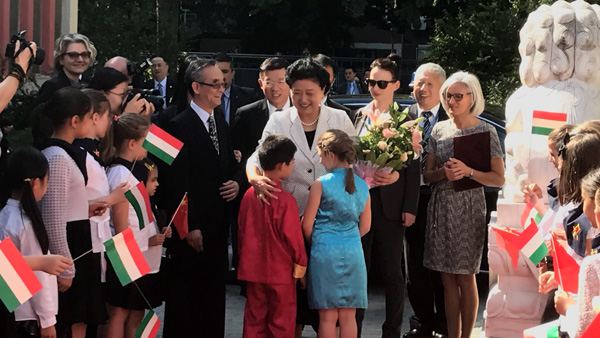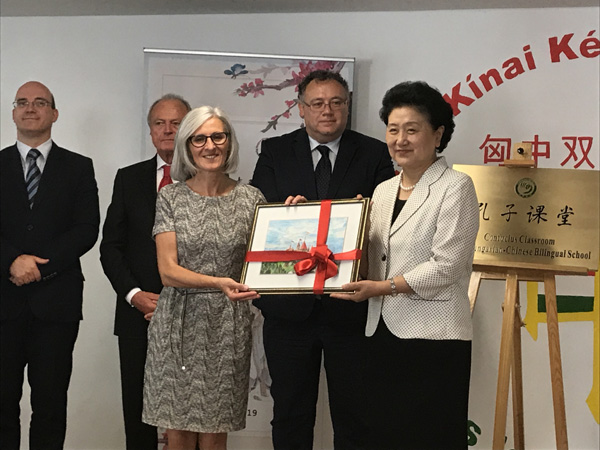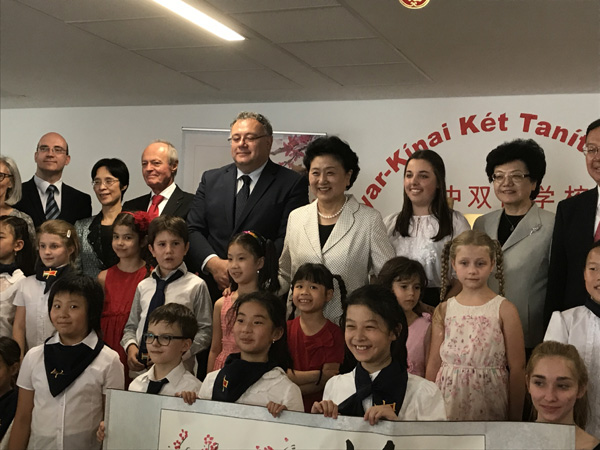
Hungarian-Chinese school opens doors to language and culture
Lei Xiaoxun
The melody of songs, recital of poems and practice of calligraphy, all in standard Mandarin, marveled visiting top Chinese officials and Hungarian dignitaries during an art performance by hundreds of students at the Hungarian-Chinese Bilingual School in Budapest on Monday.

The melody of songs, recital of poems and practice of calligraphy, all in standard Mandarin, marveled visiting top Chinese officials and Hungarian dignitaries during an art performance by hundreds of students at the Hungarian-Chinese Bilingual School in Budapest on Monday.
Joy and laughter marked a highlight of the Chinese delegation, led by Liu Yandong, vice-premier of China's State Council, who is on a high-profile trip to the Central European country to consolidate China-Central and Eastern European Countries people-to-people exchanges.
The school was established in 2004 and is now the only public school in the Central and Eastern European region offering a 12-year education taught in both Hungarian and Chinese Mandarin.
Summing up the school's previous achievements, such as the 1,000 Mandarin-speaking graduates, Liu said: "The bilingual school is unique and essential, both in terms of teaching method and the role it has played in meeting the demand of Hungarian youth to learn and experience Chinese language and culture."
Fekete Marcell Zoltan, 15, who is currently a 9th grader, said learning Chinese at the school has made him a big fan of Chinese culture.
"I know I must work really hard then I can apply to a Chinese university," he said with perfect Beijing-based Mandarin. "I want to work in China and buy a house there too. I want to live in China."
Liu said leaders of China and Hungary have shown great attention to the overall development of the school, which now offers a Mandarin-based education from elementary school to junior high, covering the 12 years of early education.

Before granting Confucius Classroom status to the bilingual school, Liu and other attendees have reflected upon the development and collective endeavors made by Hungarian Mandarin-learning and teaching institutions.
Confucius Classrooms refer to local hubs and teaching facilities where new methods are offered for Chinese language teaching and cultural learning.
There are four Confucius Schools in Hungary, with 3,800 registered students. Last year alone, the four institutes organized 240 events to help the Hungarian population experience the charm of Chinese traditions and culture, attracting more than 103,000 people.
"All Confucius institutes are supposed to find their own voice and they have to localize themselves," said Richard Mohr, director of the Confucius Institute at University of Szeged.
"We are engaged in tourism. That means we are engaging in classes in Chinese, for tourist places, tourist service providers," he said. "We are translating menus into Chinese, and for all service providers, we are helping them to make them more China company."
From a Chinese perspective, Mohr's colleague Zhang Lin, the Chinese director of Confucius institute at the University of Szeged, said it is quite a meaningful job for Chinese citizens to work in such institutions.
"We are always talking about telling stories, Chinese stories. And they [Hungarians] want to learn our stories as we are the teachers and volunteers," Zhang said.
The China-led Belt and Road Initiative has offered tremendous developmental momentum for Confucius institutions. Zhang said such advantages must be seized.
